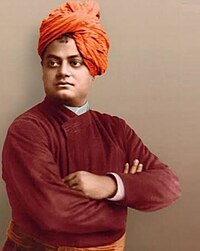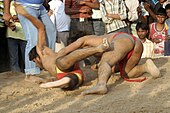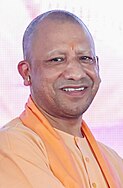Muscular Hinduism

Muscular Hinduism is a philosophy that advocates for Hindus to be physically strong. Bankim Chandra Chatterjee and Swami Vivekananda are considered to have been major early proponents in the early 20th century.[1][2][3][4][5]
History
Colonial era
The muscularisation of Hinduism in Uttar Pradesh began to occur in the early 20th century, when communal conflicts expanded and urban Hindus became more visible in performing armed displays as part of processions during their religious festivals.[6]
Gita Press, which has links to the Rashtriya Swayamsevak Sangh (RSS), is one of the oldest publishers that has supported Muscular Hinduism since the early 20th century.[7]
Muscular Hinduism has been partly inspired by fears of violence by Muslims towards Hindus, particularly towards Hindu women.[8] Muscular Hinduism was also inspired to a significant extent by Western influences such as Muscular Christianity and general British ideas of religion, sport, and masculinity,[9][10][11][12] which were propounded in South Asia during British rule, with some influences in this direction also having come from the YMCA.[13] Opposition to colonialism in general,[14][15] and British stereotyping of Indian men as effeminate was also used as a rationale for Muscular Hinduism;[16][17][18] Mahatma Gandhi propounded Muscular Hinduism as a counter to muscularity as propounded by the British during his early life as a way of addressing his feelings of physical inferiority.[19]

Muscular Hinduism promoted various sports alongside traditional Indian physical culture at a time when some practitioners of indigenous physical culture were opposed to the recently imported British physical culture and were actively standardising Indian sports for usage in formal competition,[20][8][21] with yoga in particular having been somewhat remolded into a tool of physical and martial strengthening.[22][23][21] These physical culture practices were pursued in gymkhanas and akhadas.[24][20]
Post-colonial era

Muscular Hinduism is supported by the RSS as part of a broader project to politically remake India and further nation-building;[26] this effort takes place in part in opposition to Hindus of a less nationalistic character.[27] The RSS provides paramilitary training for its members.[28] Major Bharatiya Janata Party (BJP) politicians such as Narendra Modi and Yogi Adityanath have been associated with the promotion and execution of Muscular Hinduism at the governmental level.[29][25]
The muscularity of the narratives present in the Mahabharata, which culminates in a brutal war fought for righteousness, have been propounded to a greater extent in the modern era.[30]
According to J. Sai Deepak, muscular Hinduism can be viewed as a form of decoloniality. This perspective emphasizes the reclamation of Hindu identity and values in the face of historical colonial influences, advocating for a more assertive and confident expression of Hindu traditions and beliefs.[31][32]
See also
References
- ^ Ghosh, Gautam (Summer 2015). "An 'infiltration' of time? Hindu Chauvinism and Bangladeshi migration in/to Kolkata, India". Journal of Comparative Research in Anthropology and Sociology. 6 (1): 263–288. ProQuest 1712852312.
- ^ Khilnani, Sunil (19 February 2016). "Forgotten heroes – the true story of India". The Guardian. ISSN 0261-3077. Retrieved 17 February 2024.
- ^ Madaio, James (June 2017). "Rethinking Neo-Vedānta: Swami Vivekananda and the Selective Historiography of Advaita Vedānta1". Religions. 8 (6): 101. doi:10.3390/rel8060101. ISSN 2077-1444.
- ^ Sherma, Rita D. (15 January 2021). Swami Vivekananda: His Life, Legacy, and Liberative Ethics. Rowman & Littlefield. ISBN 978-1-4985-8605-4.
- ^ Phanjoubam, Pradip (9 February 2024). "Drawing lines on terrain of the mind". The New Indian Express. Retrieved 17 February 2024.
- ^ Gooptu, Nandini (October 1997). "The Urban Poor and Militant Hinduism in Early Twentieth-Century Uttar Pradesh". Modern Asian Studies. 31 (4): 879–918. doi:10.1017/S0026749X00017194. ISSN 1469-8099. S2CID 146484298.
- ^ "Caste and the battle for secularism". The Hindu. 8 September 2015. ISSN 0971-751X. Retrieved 17 February 2024.
- ^ a b "15 Hindu Victimhood and India's Muslim Minority". academic.oup.com. Retrieved 17 February 2024.
- ^ Fletcher, Ian Christopher (2003). "Review of Ornamentalism: How the British Saw Their Empire". Victorian Studies. 45 (3): 532–534. ISSN 0042-5222. JSTOR 3830190.
- ^ Pringnitz, Keelin (4 April 2023). Shame, Modesty, Identity: Lived Religion In Athletic Spaces (Thesis thesis). Université d'Ottawa / University of Ottawa.
- ^ Arora, Namit (15 January 2013). "No saints or miracles". Himal Southasian. Retrieved 17 February 2024.
- ^ "The emergence of modern Hinduism: religion on the margins of colonialism". Library of Congress, Washington, D.C. 20540 USA. Retrieved 17 February 2024.
- ^ Alter, Joseph S. (2004). "Indian Clubs and Colonialism: Hindu Masculinity and Muscular Christianity". Comparative Studies in Society and History. 46 (3): 497–534. doi:10.1017/S0010417504000258. ISSN 0010-4175. JSTOR 3879472. S2CID 143633263.
- ^ Press, Stanford University. "Start reading Faithful Fighters | Kate Imy". www.sup.org. Retrieved 17 February 2024.
- ^ Roy, Parama (1 May 2014). "A dietetics of virile emergency". Women's Studies International Forum. 44: 255–265. doi:10.1016/j.wsif.2013.11.007. ISSN 0277-5395.
- ^ Roy, Abhik; Hammers, Michele L. (June 2014). "The Recuperation of Hindu Manhood: Echoes of the Past in Present Day Hindu Nationalism". Comparative Literature: East & West. 21 (1): 19–38. doi:10.1080/25723618.2014.12015472. ISSN 2572-3618.
- ^ van der Veer, Peter (2001). Imperial Encounters: Religion and Modernity in India and Britain. Princeton University Press. doi:10.2307/j.ctv128fp9s. ISBN 978-0-691-07478-8. JSTOR j.ctv128fp9s. S2CID 242274388.
- ^ Berti, D.; Jaoul, Nicolas; Kanungo, P. (2010). "Cultural entrenchment of Hindutva : local mediations and forms of convergence". S2CID 128700316.
- ^ The Diet of Nonviolence: Fasting and the Meaning of Masculinity in Gandhian Philosophy Chris Ruud
- ^ a b Strozier, Charles B.; Terman, David M.; Jones, James W.; Boyd, Katherine A. (19 April 2010). The Fundamentalist Mindset: Psychological Perspectives on Religion, Violence, and History. Oxford University Press. ISBN 978-0-19-970202-2.
- ^ a b Macaloon, John J. (13 September 2013). Muscular Christianity and the Colonial and Post-Colonial World. Routledge. ISBN 978-1-317-99792-4.
- ^ Alter, Joseph S. (August 2006). "Yoga at the Fin de Siècle : Muscular Christianity with a 'Hindu' Twist". The International Journal of the History of Sport. 23 (5): 759–776. doi:10.1080/09523360600673146. ISSN 0952-3367. S2CID 144740850.
- ^ Singleton, Mark (1 February 2010), "Yoga as Physical Culture I: Strength and Vigor", Yoga Body, Oxford University Press, pp. 113–142, doi:10.1093/acprof:oso/9780195395358.003.0007, ISBN 978-0-19-539535-8, retrieved 17 February 2024
- ^ Delap, Lucy; Morgan, Sue, eds. (2013). "Men, Masculinities and Religious Change in Twentieth-Century Britain". SpringerLink. doi:10.1057/9781137281753. ISBN 978-1-349-44828-9.
- ^ a b Rafiq, Arif (14 August 2019). "Hindu Nationalist Extremist Emerges as India's Most Favorite State Leader". Globely News. Retrieved 17 February 2024.
- ^ Banerjee, Sikata (1 February 2012). Make Me a Man!: Masculinity, Hinduism, and Nationalism in India. State University of New York Press. ISBN 978-0-7914-8369-5.
- ^ Reader, The MIT Press (28 February 2022). "The Rise of Hindu Nationalism". The MIT Press Reader. Retrieved 17 February 2024.
- ^ Subramanian, Samanth (10 October 2022). "When the Hindu Right Came for Bollywood". The New Yorker. ISSN 0028-792X. Retrieved 17 February 2024.
- ^ Rageth, Nina; Landau, David (28 September 2023), Copeman, Jacob; Longkumer, Arkotong; Duggal, Koonal (eds.), "Governing with a Lockdown Beard: The COVID-19 Crisis as a Laboratory for Narendra Modi's Hindutva", Rageth, Nina; Landau, David (2023). Governing with a Lockdown Beard: The COVID-19 Crisis as a Laboratory for Narendra Modi’s Hindutva. In: Copeman, Jacob; Longkumer, Arkotong; Duggal, Koonal. Gurus and Media. Sound, Image, Machine, Text and the Digital. London: UCL Press, 125-148., London: UCL Press, pp. 125–148, ISBN 978-1-80008-556-5, retrieved 17 February 2024
- ^ Kanjilal, Sucheta. "Muscular Mahabharatas: masculinity and transnational Hindu identity." Nidan: International Journal for Indian Studies 3.2 (2018): 18-39.
- ^ Deepak, J Sai (2021). India that is Bharat: Coloniality, Civilisation, Constitution. Bloomsbury India. ISBN 978-9354352492.
- ^ "Bharat is moving away from colonial vestiges: J Sai Deepak on Central Vista project". India Today. 4 November 2022. Retrieved 13 October 2024.
